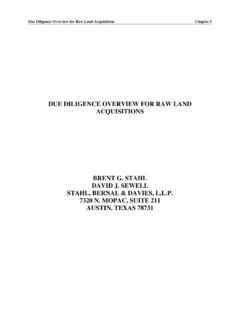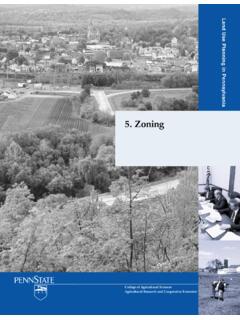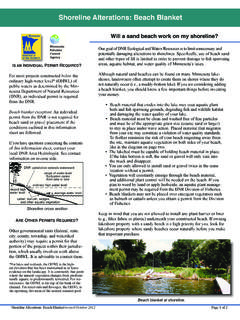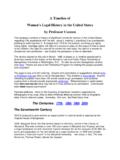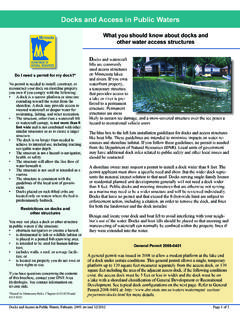Transcription of THE SEVERANCE OF WIND RIGHTS IN TEXAS By: Lisa Chavarria ...
1 THE SEVERANCE OF WIND RIGHTS IN TEXAS1 By: Lisa Chavarria Stahl, Bernal & Davies, LLP 7320 N. MoPac, Suite 211 Austin, TEXAS 78731 (512) 652-2947 Although it is well established under TEXAS law that the fee simple owner of property can sever the surface from the minerals thereby creating two separate estates,2 TEXAS law is silent on whether the right to develop (or not develop) the wind that flows across property may be severed from the surface estate. With the widespread development of utility scale wind energy projects wind has proven that it, like minerals, can have a distinct value. But do wind RIGHTS retain their classification as property if severed from the surface?
2 Can you ever really sever wind RIGHTS from the surface or are RIGHTS to the wind just another type of interest in the surface? This paper will explore wind as a property right and discuss whether wind is capable of SEVERANCE from the surface estate. As a part of that discussion the risks of severing wind RIGHTS will be identified and suggestions regarding the type of duties and RIGHTS that should be included in a wind deed are made. Finally, as an alternative to a complete SEVERANCE of wind RIGHTS , a conveyance of a royalty interest in the wind estate is explored. Wind as a Property Right A preliminary question is whether wind is property.
3 As we all know, property can include concepts and methods not just objects that can be physically possessed. For example, through patent law, procedures and methods can be property RIGHTS , capable of purchase and sale in the marketplace. In this author s view something is classified as property once the marketplace assigns value to that thing or concept and the law in turn endorses that classification. In Theories of Legislation, Jeremy Bentham wrote, Property is nothing but a basis of expectation; the expectation of deriving certain advantages from a thing which we are said to possess, in consequence of the relation to which we stand towards it.
4 3 The advent of utility scale wind turbines and the need for new energy sources has given individuals who own windy property the expectation of profit. That the surface owner holds the right to the wind that flows across it is supported by TEXAS common law - Cujus est solum, ejus est usque ad coelum et ad inferos to whomsoever the soil belongs, it is theirs up to the sky and down to the Although at common law TEXAS subscribed to this unified theory of property ownership, it has since been qualified to 1 An earlier version of this paper first appeared as Lisa Chavarria , Undertaking the SEVERANCE of Wind RIGHTS , Oil Gas & Energy Resources Law Section Report, Vol.
5 32 December 2007. What follows is substantially the same paper with additions to the Classifying Wind RIGHTS and The Wind Deed sections. 2 Bagby v. Bredthauer, 627 190, 194 ( Austin 1981, no writ). 3 BENTHAM, supra note 1 at 111. 4 See 2 WILLIAM BLACKSTONE, COMMENTARIES ON THE LAW OF ENGLAND 18 (William Draper Lewis ed., 1902) (discussing the cujus est solum doctrine). 1 recognize a landowner s use of his airspace may not interfere with air Thus, the right to use the land to establish the necessary equipment to build a wind farm and the right to use the airspace appurtenant to land both reside with the surface owner. Accordingly, it must be concluded that the owner of the surface estate holds the right to develop (or not develop) the wind that flows across the property.
6 The wind lease is widely used as the legal instrument through which a landowner leases to a wind company, for a defined number of years, the right to develop a wind project. Although the wind industry and wind leases in TEXAS are relatively new, the TEXAS wind lease has quickly become standardized in several respects. The nature of the interest conveyed is a leasehold interest, the language describing the RIGHTS reserved by the wind company and a landowner s right to receive the greater of minimum rent and a royalty payment are all prevailing standards in TEXAS wind leases. As of the date of this paper, there is no TEXAS litigation challenging the legal validity of the RIGHTS conveyed by a wind lease.
7 Although there will certainly be disputes over the interpretation of certain lease clauses, that a TEXAS court would not uphold a wind lease as a valid conveyance of the RIGHTS contained therein is hard to imagine. The wind lease provides a landowner, who may be without the necessary capital and expertise to develop a wind project, with the ability to convey a leasehold interest to the party who can. In this respect, a wind lease is not conceptually different from an agricultural lease given by one who owns fertile property but who is not a capable farmer. Significantly, an invalidation of wind leases would put the legal RIGHTS to billions of dollars of investment in jeopardy and most certainly put an end to any future investment in the TEXAS wind industry.
8 In short, it is unlikely TEXAS courts would not endorse the ability of a landowner to grant, and a wind company to lease, the surface estate for the development of a wind project. Hence the marketplace has assigned value to wind RIGHTS and it is unlikely the law will not uphold a surface owner s right to convey a leasehold interest in wind RIGHTS . An analysis of wind RIGHTS should not be limited to a discussion of wind s value upon conversion into electricity. In a previous paper, I limited the discussion of severing wind RIGHTS to how one comes to possess the Such an analysis ignores the possibility that a surface owner may place greater value on not converting wind into electricity and may elect to forego developing a wind project on his property.
9 A surface owner may also place great value on his neighbor not building a wind project on his property and seek to purchase his neighbor s wind RIGHTS or airspace. The concept of imposing limitations or affirmative obligations designed to preserve the natural character of property is not new and is already embodied by the TEXAS 5 United States v. Causby, 328 256, 66 1062, 90 1206. See also, Schronk v. Gilliam 380 SW2d 743, 744 (Tex. Waco 1964, no writ), citing Hotchkiss, Aviation Law, Sec. 22; American Law Inst., RESTATEMENT, TORTS, SECS. 159, 194; United States v.
10 Causby, 328 256, 66 1062, 90 1206; 2 Aerial Navigation 5, p. 903; 8 Sec. 5, p. 621. See generally, 99 176 and supp.; 3 JOURNAL AIR LAW, 329, 531; Wherry & Condon, 6 Air Law Rev. 113; Anderson, Airspace Trespass, 27 Journal Air Law 341 (1960); Harper, Torts, Sec. 37, p. 74; Prosser, Torts (1955) Sec. 13, p. 60; Harper & James, Torts, Sec. ; 78 902; 6 Cornell L. Q. 271; Calkins, Landowner and Aircraft, 25 Journal Air Law 373 (1958). 6 See : Lisa Chavarria , Wind Power: Prospective Issues, 68 TEX. 832 (2005) (discussing the possession of wind as the process by which wind is transformed into electricity in large quantities and delivered to an electric grid for use by consumers).
